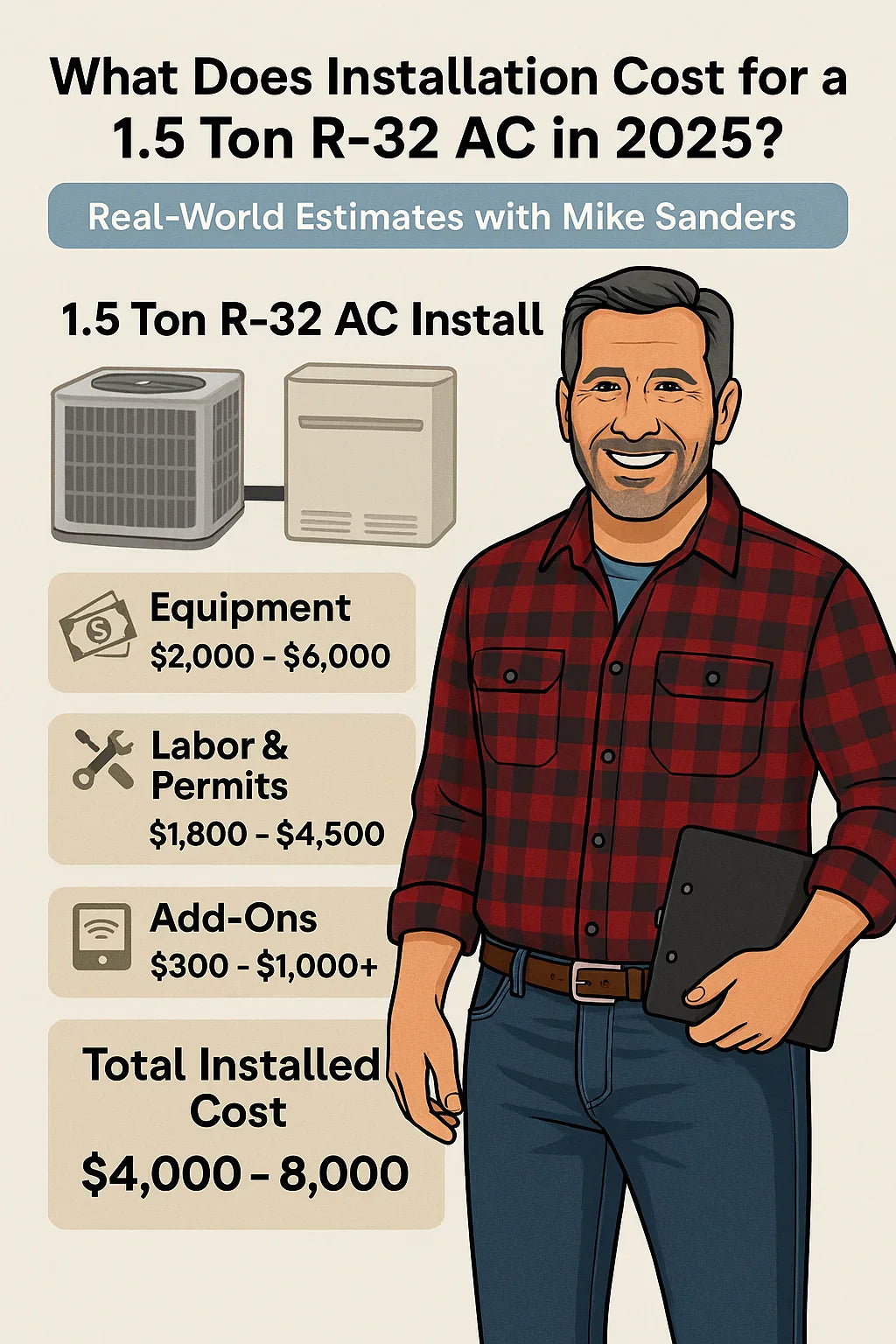🔎 Introduction
-
Set the scene: Mike is budgeting for an upgrade from his old R‑410A system to a 1.5‑ton R‑32 AC.
-
Why cost matters more in 2025 (new SEER2 standards, R‑32 refrigerant, and rising labor rates).
-
Promise: By the end of this article, homeowners will know what a realistic budget looks like.
💡 1. Key Factors That Shape Installation Costs
-
Equipment brand & efficiency rating (SEER2 14.3 vs. 17+)
-
Labor rates in your area
-
Electrical upgrades (breaker box, dedicated circuit, wiring)
-
Ductwork condition (repair, sealing, or new installation)
-
Permits and inspections (local code compliance)
-
Optional add‑ons (smart thermostats, surge protectors, dehumidifiers)
📊 2. Average Cost Ranges in 2025
Equipment Price
-
1.5‑ton R‑32 condenser + air handler:
-
Budget models: $2,000–$3,200
-
Mid‑range Energy Star models: $3,200–$4,500
-
High‑efficiency inverter systems: $4,500–$6,000
-
Labor & Installation
-
Professional install (basic): $1,800–$2,800
-
With ductwork modification: $2,800–$4,500+
Total Installed Cost
-
$4,000–$8,000 (depending on complexity)
(Backed by 2025 HVAC industry averages and regional reports)
🛠️ 3. Mike’s Breakdown: Where the Money Goes
-
$4,200: Goodman 1.5‑Ton 15 SEER2 R‑32 Split System
-
$2,000: Professional labor, permits, electrical panel upgrade
-
$600: Smart thermostat + surge protection
-
$6,800 Total
Mike emphasizes: “Always get at least 3 quotes and ask about hidden costs before signing.”
🧾 4. Hidden & Extra Costs Homeowners Often Miss
-
Disposal of old unit ($200–$400)
-
Refrigerant line set replacement ($250–$600)
-
Concrete pad for outdoor unit ($150–$300)
-
Permit fees ($100–$500, depending on city)
-
Maintenance plan upsells ($150–$300/year)
🌍 5. Rebates, Tax Credits & Incentives in 2025
-
Federal Energy Tax Credit: Up to $2,000 for qualifying Energy Star R‑32 heat pump systems (Energy.gov)
-
State & local utility rebates: Range $300–$1,500 (DSIREusa.org)
-
Many homeowners can reduce total install cost by 10–20% with rebates.
🛡️ 6. DIY vs. Professional Install: Worth the Savings?
-
DIY Savings: Skip $2,000–$3,000 in labor costs.
-
Risks:
-
Warranty voided without licensed install
-
R‑32 requires EPA‑certified handling
-
Safety concerns (electrical & refrigerant)
-
-
Mike’s advice: “Unless you’re a trained pro, don’t DIY R‑32 installs—the risks outweigh the savings.”
📈 7. Cost vs. Value: Why Paying More Upfront Saves Later
-
Higher SEER2 = lower monthly utility bills
-
R‑32 refrigerant = lower service costs
-
Professional install = longer system life & fewer repairs
-
Resale benefit: Buyers prefer future‑proof R‑32 systems
📊 8. Quick Comparison Table
| Cost Component | Low-End Estimate | High-End Estimate |
|---|---|---|
| Equipment (1.5 ton R‑32) | $2,000 | $6,000 |
| Labor & Permits | $1,800 | $4,500 |
| Add‑Ons (thermostat, pad) | $300 | $1,000+ |
| Total Installed | $4,000 | $8,000 |
✅ Conclusion
For Mike and homeowners like him, a 1.5‑ton R‑32 AC install in 2025 realistically costs $4,000–$8,000, depending on equipment efficiency, labor, and add‑ons. With rebates and lower utility bills, the investment pays back in just a few years—making R‑32 not only the eco‑friendly choice but the smart financial one.
In the next topic we will know more about: Maximizing Efficiency: Thermostat & Filter Hacks for Your 1.5 Ton System







